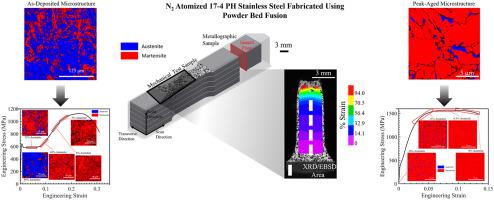Materials Science and Engineering: A ( IF 6.1 ) Pub Date : 2021-05-04 , DOI: 10.1016/j.msea.2021.141363 D.J. Shaffer , A.E. Wilson-Heid , J.S. Keist , A.M. Beese , T.A. Palmer

|
Additively manufactured precipitation hardened (PH) martensitic grade stainless steels display wide variations in their heat treatment response and mechanical properties. Much of this variability can be attributed to the selection of the atomizing gas and the resulting variations in powder composition. Differences in nitrogen compositions present in argon and nitrogen atomized powders led to the formation of a wide range of retained austenite levels between 0 and 81 vol% and significant differences in mechanical properties in as-deposited and aged 17-4 PH grade stainless steels. Material fabricated using argon atomized powder contained little to no retained austenite and displayed mechanical properties in the peak-aged condition similar to those in wrought alloys (1359 ± 59 MPa ultimate tensile strength and 10.1 ± 0.8% elongation to failure). On the other hand, materials fabricated with nitrogen atomized powder displayed between 20% and 81% retained austenite, leading to discontinuous yielding driven by the strain-induced transformation of the retained austenite to martensite. Even with the presence of this discontinuous yielding, the materials fabricated using the nitrogen atomized powders consistently displayed strengths 300 MPa higher in the as-deposited, 200 MPa higher in the peak-aged, and 500 MPa higher in the over-aged conditions than materials fabricated using the argon atomized powders. By directly comparing the local strains and microstructures in nitrogen atomized materials, a [011]γ//[001]α relationship in line with the Bain transformation process was present between the retained austenite and transformed martensite across the as-deposited and aged conditions.
中文翻译:

残余奥氏体对增材制造的17-4 PH级不锈钢的时效的影响
增材制造的沉淀硬化(PH)马氏体不锈钢在热处理响应和机械性能方面表现出很大的差异。这种可变性的大部分可以归因于雾化气体的选择以及所导致的粉末组成的变化。氩气和氮雾化粉末中氮元素的差异导致在0至81 vol%的范围内形成大量的残余奥氏体含量,并且在沉积和时效的17-4 PH级不锈钢中,其机械性能也存在显着差异。用氩气雾化粉末制成的材料几乎没有残留奥氏体,并且在峰值时效条件下显示出与锻造合金相似的机械性能(极限拉伸强度为1359±59 MPa,断裂伸长率为10.1±0.8%)。另一方面,用氮雾化粉末制成的材料显示出20%至81%的残余奥氏体,从而导致应变不均一,这是由应变引起的残余奥氏体向马氏体转变的驱动。即使存在这种不连续的屈服,使用氮原子雾化粉末制造的材料在沉积状态下的强度也始终比材料高300 MPa,峰值时效200 MPa和过时效高500 MPa。使用氩气雾化粉末制造的。通过直接比较氮气雾化材料中的局部应变和微观结构,[011] 导致由残余奥氏体向马氏体的应变诱导转变驱动的不连续屈服。即使存在这种不连续的屈服,使用氮原子雾化粉末制造的材料在沉积状态下的强度也始终比材料高300 MPa,峰值时效200 MPa和过时效高500 MPa。使用氩气雾化粉末制造的。通过直接比较氮气雾化材料中的局部应变和微观结构,[011] 导致由残余奥氏体向马氏体的应变诱导转变驱动的不连续屈服。即使存在这种不连续的屈服,使用氮原子雾化粉末制造的材料在沉积状态下的强度也始终比材料高300 MPa,峰值时效200 MPa和过时效高500 MPa。使用氩气雾化粉末制造的。通过直接比较氮气雾化材料中的局部应变和微观结构,[011] 与使用氩气雾化粉末制造的材料相比,在过时效条件下的压力要高出500 MPa。通过直接比较氮雾化材料中的局部应变和微观结构,[011] 与使用氩气雾化粉末制造的材料相比,在过时效条件下的压力要高出500 MPa。通过直接比较氮气雾化材料中的局部应变和微观结构,[011]在沉积和时效条件下,残余奥氏体和相变马氏体之间存在符合贝恩相变过程的γ // [001] α关系。











































 京公网安备 11010802027423号
京公网安备 11010802027423号